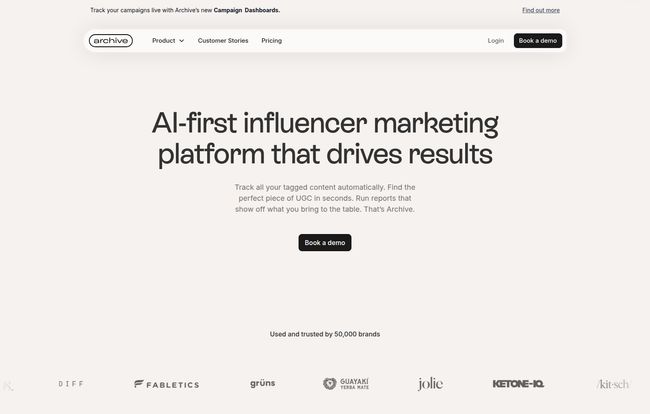You and me. As a marketer, you know the feeling. That little thrill when you see a customer post an amazing photo or video with your product. That's gold, right there. User-generated content, or UGC, is the holy grail of authentic marketing. It’s real, it’s persuasive, and it builds trust way better than our slick, polished ads ever could.
But then comes the crash. The reality of trying to actually manage all that gold. It’s a chaotic mess of screenshots, saved Instagram posts, messy spreadsheets, and endless scrolling through tagged content. Before you know it, you're spending hours just hunting for content instead of using it. I’ve been there. We've all been there. It’s the digital equivalent of hoarding, and it’s exhausting.
So when I hear about an “AI-first influencer marketing platform” that promises to solve this exact problem, my ears perk up. But my skepticism meter goes up, too. We've seen a million tools promise to revolutionize our workflow. Today, we're looking at one called Archive. Does it live up to the hype? Let's get into it.
So, What is Archive, Really?
Putting the fancy marketing-speak aside, Archive is a tool designed to automatically find, collect, and organize all the UGC your brand gets mentioned in. Think of it as a super-smart digital assistant whose only job is to watch Instagram, TikTok, and other platforms for any time someone tags your brand. When it finds something, it snags it, saves it in a clean library, and even pulls in all the important data associated with it. No more screenshots, no more broken links. It’s built for brands drowning in content and data, claiming it can save teams over 40 hours a week. A bold claim, but one that feels pretty believable if you’re still doing things by hand.
Drowning in Content? Archive Throws You a Life Raft
The core of Archive's appeal is its ability to create order from chaos. For any brand that gets a decent amount of social media love, managing it is a full-time job. It’s scattered, disorganized, and disappears as quickly as it appears.
Finally, Automated Content Collection
I can’t tell you how many times I’ve seen a brilliant piece of UGC, made a mental note to “come back to that,” and then promptly lost it forever in the ever-churning feed. Archive’s primary function is to stop that from happening. It automatically pulls any content where your brand is tagged into a central library. And we're talking high-quality downloads, not fuzzy, watermarked screenshots. This alone is a real life-saver. It’s like having a net that catches every valuable piece of content so you can decide what to do with it later, stress-free.

Visit Archive
Finding That One Video with AI Search
Okay, so you’ve collected hundreds, maybe thousands of posts. Now what? How do you find that one video of a customer unboxing your product from two months ago? Scrolling? Good luck.
This is where the “AI-first” part starts to make sense. Archive's search is more than just keywords or hashtags. It claims to let you search by objects, sentiment, or even aesthetics. Need a video with a “minimalist vibe” featuring a “dog”? It’s designed to find that for you. This transforms your UGC library from a digital graveyard into a searchable, genuinely useful asset database. For a creative team on a deadline, that’s not a small thing.
Turning Messy Data into Money
Having a library of pretty pictures is nice. But as marketers, we're accountable for results. We need to prove ROI. We need to show that our efforts are actually moving the needle. This is often the most painful part of influencer and UGC marketing.
Ditching the Clunky Spreadsheets
If you've ever tried to manually build a campaign report by copying and pasting likes, comments, views, and calculating engagement rates... I feel your pain. It’s tedious, soul-crushing work that’s probably outdated by the time you finish it. Archive promises one-click reports. It pulls real-time metrics for your campaigns, showing you everything from engagement to estimated reach and, importantly, estimated media value. This is the kind of data that makes your CFO happy. It turns a “we think this is working” feeling into a “this campaign generated $X in media value” statement.
Beyond Collection: Rights, Payments, and Conversions
Archive isn’t just a fancy filing cabinet. It tries to close the loop on the entire UGC lifecycle, from discovery to conversion.
Getting Permission Without the Awkward DMs
One of the sketchiest areas of UGC is usage rights. Just because someone tagged you doesn’t mean you can legally splash their photo on a billboard or use it in a paid ad. Securing rights is a huge, and often ignored, legal step. Archive has tools built in to help manage this process, requesting and tracking permissions so your legal team can sleep at night. This is a sign of a mature platform that understands the real-world complexities of marketing.
Shoppable Feeds: The Holy Grail
This is where it gets really interesting for e-commerce brands. Archive allows you to create shoppable UGC feeds for your website. You take all this amazing, authentic content and make it directly actionable. A customer sees someone just like them loving your product, and they can click to buy it right there. The site claims this can lead to a 5-10% increase in conversion rates. In the world of e-comm, that's a massive lift. It’s the difference between content that’s just nice to look at and content that actively generates revenue.
So, What's the Catch?
No tool is perfect, and it’s important to be realistic. Based on the info and my own experience with similar platforms, there are a few things to consider.
- The Setup: An “automated” platform still requires initial setup, integration, and learning. You'll need to invest some time upfront to get it running smoothly.
- Content Source: It's brilliant for tagged content. But if your customers are talking about you without tagging your official handle, the tool might miss it. Your success depends on your community's existing habits.
- The Price Tag: This is not a $29/month plugin. A platform this powerful is an investment. Which brings us to the big question…
How Much Does Archive Cost?
You might have noticed there’s no pricing page on their website. It’s all “Book a demo.” That’s the classic signal for enterprise-level, custom pricing. When you go to book a demo, the form asks for your company size and revenue. Translation: the price will be tailored to your business, and it probably won't be cheap. This isn't for the solo-preneur or the brand just starting out. This is for established brands and agencies who are feeling the operational pain of success and can justify the cost with the time saved and performance gained.
Frequently Asked Questions about Archive
1. What exactly does Archive do?
Archive is an AI-powered software platform that automatically finds and collects user-generated content (UGC) where your brand is tagged. It organizes this content, provides detailed analytics, helps manage usage rights, and allows you to create shoppable galleries for your website.
2. Is Archive a good choice for small businesses?
It depends. Given its custom pricing model and powerful feature set, Archive is likely best suited for established brands and agencies that receive a high volume of UGC. A very small business or startup might not have the budget or the volume of content to get the full value from the platform.
3. How does Archive find my brand's UGC?
The platform primarily works by tracking specific social media handles and hashtags that you define. It automatically detects when users tag your brand on platforms like Instagram and TikTok and pulls that content into your dashboard.
4. Can I pay creators directly through Archive?
Yes, the features list includes 'Creator Payouts,' indicating that the platform has functionality to help you compensate creators for their content, streamlining another part of the influencer maketing workflow.
5. Does it integrate with my e-commerce store?
Yes, a key feature is the creation of shoppable UGC feeds, which are designed to be embedded on your website. They also list an API in their site footer, suggesting custom integrations with platforms like Shopify, BigCommerce, or others are possible.
The Final Verdict: Is Archive the Real Deal?
After looking at what Archive offers, I have to say, I'm genuinely impressed. It’s not just another tool; it’s a well-thought-out solution to a very real, very frustrating problem. For any marketing team that's reached a certain scale, the manual method of managing UGC just isn’t sustainable. It’s a bottleneck that stifles creativity and kills productivity.
Archive seems to tackle the entire workflow—from the initial chaos of collection to the critical final steps of reporting and conversion. It's built for serious brands like Fabletics, Notion, and Kit-sch that understand the immense value of social proof and need an efficient way to harness it.
If you're spending more of your day hunting for great content than you are actually marketing with it, then booking a demo with Archive might be the most productive thing you do all week. It could be the very thing that finally tames the UGC beast for good.



